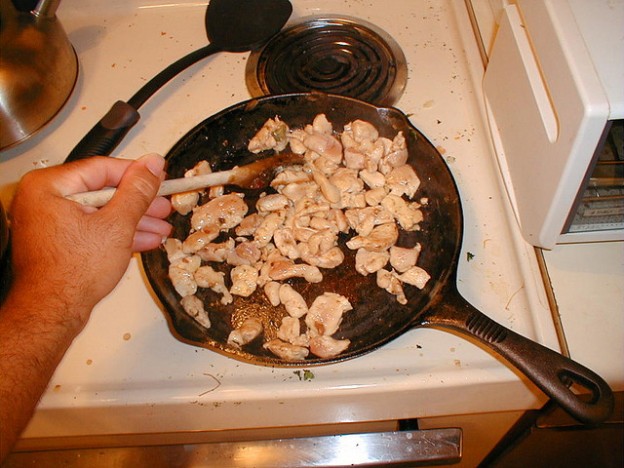I love my dad, but – and I hope he doesn’t take offense to this – he’s not much of a cook.
When I think back on his culinary contributions to the family growing up, they were always a bit dubious, if well-loved. He lorded over Bisquick pancakes and waffles on weekend mornings, and was so convinced that other family members were unworthy of this task that I didn’t learn to flip a pancake until I was 19 years old. He’s famous for leaving things in the oven and forgetting about them – I’m sure that the charred bottom of our toaster oven is simply a layer of fossilized pizza bagels. Many nights, to our mother’s displeasure, he would surprise the family with a dinner of fast food – General Tso’s, fries from a local burger shop, or a pie from one of Connecticut’s excellent pizzerias.
I wish I could say my dad would love the man-centric cookbook sent to me for review this month - Esquire’s Eat Like a Man – but, as you’ve probably discerned, he isn’t the cookbook type. Many of the book’s recipes contain vegetables, after all, something which would be enough to make my dad highly skeptical. Slightly more adventurous men, however, are sure to lust after the book’s collection of comfort food recipes, which make Gargoyles on the Square’s chocolate bacon panini look subtle and refined. I’ll read some of the recipe titles, for your food porn pleasure: “Lobster Scrambled Eggs.” “Jalapeno-and-Ancho Oatmeal.” “Catfish Sloppy Joe.” Something called “Stuffed Meat Bread.” “Coca-Cola Brined Fried Chicken.” Yes, man-food all – except, oddly, the only dessert in the whole cookbook (nay, the book says, “The Only Dessert You’ll Ever Need”) which, spoiler alert, is a rather feminine fruit crisp and not, say, a chocolate bacon panini.
I admit that before this book, I had never thought of food as gendered – but now, even I, a committed feminist, must concede that there’s something about these dishes that appeal to a certain mindset (and metabolism) that I don’t possess. So what makes a meal manly? Often, the cookbook suggests, the inclusion of red meat helps make that distinction; other times, it’s an unholy amount of processed carbohydrates. But more than that, manly food is an attitude. Generally speaking, men eat without guilt. Women often don’t, and that’s obviously a huge societal problem that expresses itself in everything from binge eating and anorexia to stupid yogurt commercials. We ladies could probably learn a lot about eating for the sake of pure enjoyment from men. Likewise – if this cookbook is any indication – men could probably learn a thing or two about healthy, feel-good eating from us. As much as we’d all like to, we can’t subsist on truffled macaroni and cheese (page 189) forever.
I think many men realize this, particularly as they increasingly are in charge of feeding their families. So it was a delight to read Man with a Pan, which is not a cookbook but a collection of vignettes about dads who cook, edited by The New Yorker‘s John Donahue and filled with top-notch contributors from Stephen King to Mark Bittman. Compared with the machismo of Eat Like a Man, it is a surprisingly progressive and downright feminist book – there’s even a chapter by Shankar Vendantam on hidden prejudices surrounding gender and cooking. If anyone wants proof that the women’s rights movement has also helped men, they need to look no further than the joy these guys take from what was once a task confined solely to wives or their servants.
In a weird way, my dad is one of these men. Yeah, he fed us fast food – but he had a sense of duty about the whole thing. Many nights, it was my dad filling that stereotypical wifely role – frequently, he was the partner who put food on the table. He worked at home; my mom worked in an office miles away and some nights wasn’t back until 8. So we feasted on grilled cheeses, Oreo cookies, Cherry Garcia.
Though none of the contributors in Man With a Pan is quite this hung up on junk food, it’s a mixed bunch. Included with the stories are an eclectic bunch of recipes – from King’s adaption of an allrecipes.com cake to Jim Harrison’s method of preparing grouse he’s hunted himself – that didn’t exactly inspire me to start cooking, but were nonetheless poignant in their individuality. The writers come from different skill levels, different sensibilities (there are committed carnivores and thoughtful vegetarians) and different backgrounds. In a nice touch, not all the contributors are famous or wealthy or journalists – blue collar workers, bankers and football coaches get some representation here.
As different as both books are, it is a nice idea to think that they may help usher in an era of equality in the kitchen, where men and women each partake in the joy of cooking. Either would be a thoughtful gift for a foodie dad.
For my dad, however, pass the Bisquick – no lobster or truffles required. Yeah, I can hear organic foodies tsking our Standard American Diet, but Dad’s food was, I believe, a pure expression of love. These were the foods that made his often stressful life better – I rarely saw him happier than when he was eating a cup of good Italian ice or a piece of chocolate. Sharing this comfort food was how he connected to us, and how I tried to understand him – for many years, my Christmas present to him was a box of chocolate-covered macadamia nuts.
We were true, committed emotional eaters – and when I turned down a Marie Callender Chicken Pot Pie on my last visit, he looked visibly disappointed. Disappointment, differing food philosophies, arguments over vegetables – such is the emotional risk of life in the post-feminist kitchen.

